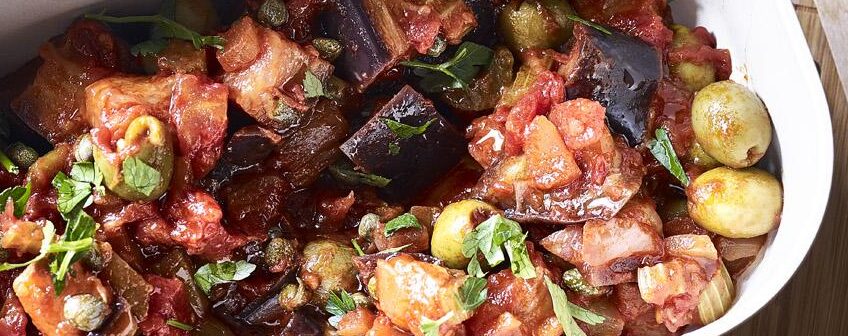Caponata Siciliana
The variety and the richness of the Sicilian cuisine is undeniable. Its food is full of familiar flavours, but delivered in a language that clearly represents the sum of all the influences that Sicily has absorbed through the centuries. Cuisine is always an instrument of identity. Caponata, for the Sicilian region, is one of them.
At first sight, you’d be forgiven for mistaking a caponata for a simple aubergines stew.
But once you dive your taste buds into a delicious mouthful of the authentic Sicilian recipe, the pleasure of what you are eating will engulf you. And caponata is not just “aubergines in a pan”, but also a legitimate example Sicily’s rich heritage – on a plate.
Aubergines came originally from the North of India and Persia, but were brought into Europe by the Arabs in the VII century, when they came over to conquer the Iberian peninsula. When first introduced, the aubergine was not enthusiastically received: on the contrary it was called the “egg of the devil” and people believed that, if eaten, it could cause a darkening of the skin and other kind of diseases. In the 1500s it was even suggested that the Arabs had brought the aubergine to Europe as a weapon to destroy Cristianity!
The origin of the name has been widely discussed, but the most accredited version is that it derives from ‘capone’. Lampuga – or capone in Sicilian dialect – is the so-called dolphinfish very common in the Mediterranean Sea. Capone, cooked in a form of bitter-sweet sauce, was a popular main course in the 1700s at the aristocrat’s table.
Over the centuries and also thanks to the island’s different periods of dominations, the dish evolved into the vegetarian option we know today.
In the history of Italian cuisine in general, very many dishes were “born of necessity” because people, being poor, sought to avoid both waste and the purchase of resources. This version of caponata was more accessible to those who could not afford to buy fish.
Although caponata’s main ingredient is the aubergine it contains a variety of other interesting ingredients, all important for their connections with the island and its history: celery, onions, tomatoes, almonds, olives and capers. These last gives a real depth of flavour to the dish – while a little sugar and a dash of vinegar provide the essential sweet-and-sour touch that has always been retained.
Every town and every family in the island has its own version of the caponata, of course. The recipe is religiously preserved, but at the same time generously shared. Agrigento, Trapani, Messina, Palermo, Catania, each with its own version, all claim to make the best caponata in the region!
Aubergines, still extensively cultivated in Sicily as well as much of the rest of Italy, and Spain, are available at almost any time of year, but the best time to eat them is late spring through summer. There is nothing better than having your caponata (or even a fried parmigiana – of which we will talk another time!) – in August, when the tomatoes have also reached their peak ripeness and carry the flavour of the southern Italian sun.




